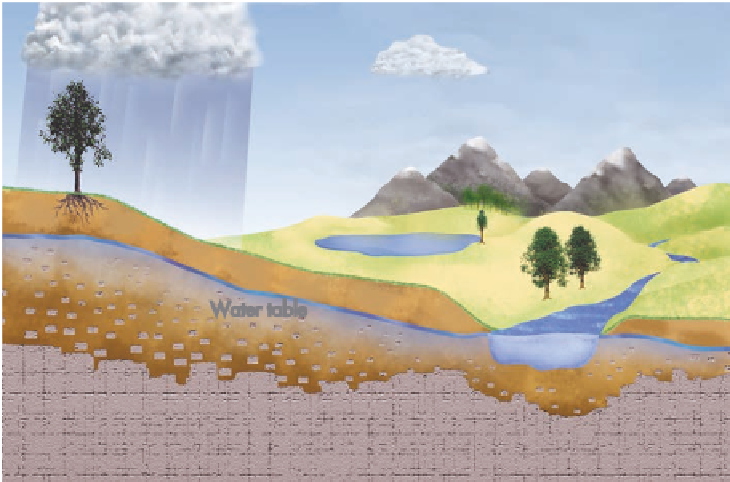Geoscience Reference
In-Depth Information
Figure 11.3 Delivery of water to soil.
Soils
receive most of their water from rain and
melting snow, which move downward into
the soil by infiltration. The soil also receives
water stored below the ground by capillary
action.
Evapotranspiration
Precipitation
Runoff into
streams
Infiltration downward
to water table
Water table
Capillary action
upward
Bedrock
by helping to hold it together and (b) microorganisms within
humus give off compounds of nitrogen, phosphorus, sulfur,
and other mineral substances that are nutrients for plants.
3.
Water
Water is critical to soils for a variety of reasons.
The most obvious reason is that plants require water to
grow. In turn, high plant production contributes to increased
biomass, which generally results in more humus produc-
tion and stable, more fertile soils. Water is delivered to soils
in the form of rain and melting snow (Figure 11.3). After
precipitation occurs, water can take several pathways with
respect to the soil. If the precipitation is heavy, or if it falls
on soils that are already very wet, some or most of the wa-
ter will flow across the surface into local rivers and streams
as runoff and never be absorbed into the soil.
the attraction between water molecules. To see how capillary
action works, fill a transparent glass about halfway with water.
If you look at the side of the glass, where the water meets the
inside surface, you can see that the edge of the water actually
climbs a short way up the side of the glass. Water molecules
have a slightly stronger attraction to the glass than they do to
other water molecules. Capillary action in soils works the same
way.
Although most water is flushed from the soil pores during
the draining process, some remains in the soil-water belt because
it is held to soil particles by the force of
surface tension
.
Observe for yourself how surface tension works. Splash a few
Capillary action
The force that causes water to rise in the
small tubular conduits within the soil.
When snow melts slowly, rain falls relatively slowly, or the
soil is dry, water has a tendency to more readily infiltrate into
soils. Once infiltration begins, some water will either evaporate
into the atmosphere directly from the ground or when plants
absorb it through their roots and carry it to their leaves through
the process of transpiration. In the context of soil-water loss, the
combined processes of evaporation and transpiration are often
lumped together in the single term
evapotranspiration
, which
we described in Chapter 9.
Let's examine what happens to the soil water that is not
lost immediately by evapotranspiration. A soil is
saturated
when water mostly fills all available pore spaces, except for a
few small pockets of air here and there (Figure 11.4). Subse-
quently, within a few days, all excess water drains downward
under the force of gravity toward the underlying groundwater
zone, leaving larger pockets of air behind. Although most of
this downward-moving water is lost as far as the soil is con-
cerned, some of it will be pulled back up into the soil at a later
time through the process of
capillary action
(see Figure 11.3).
This occurs when the molecular attraction at the boundary
between the underlying water and soil particles is stronger than
Surface tension
The contracting force that occurs when the
water surface meets the air and acts like an elastic skin.
Air
Air
Water
Water
Air
Soil
particles
Soil
particles
(a) Wet (saturated) soil
(b) Dry soil
Figure 11.4 Wet vs. dry soils.
(a) A soil is considered to be
saturated when pore spaces are nearly full of water, which occurs
after extended periods of precipitation or snowmelt. (b) Subse-
quently, water drains under the force of gravity, leaving water held
to soil particles by surface tension. When most of the downward-
moving water is lost, the soil is dry.












































































































